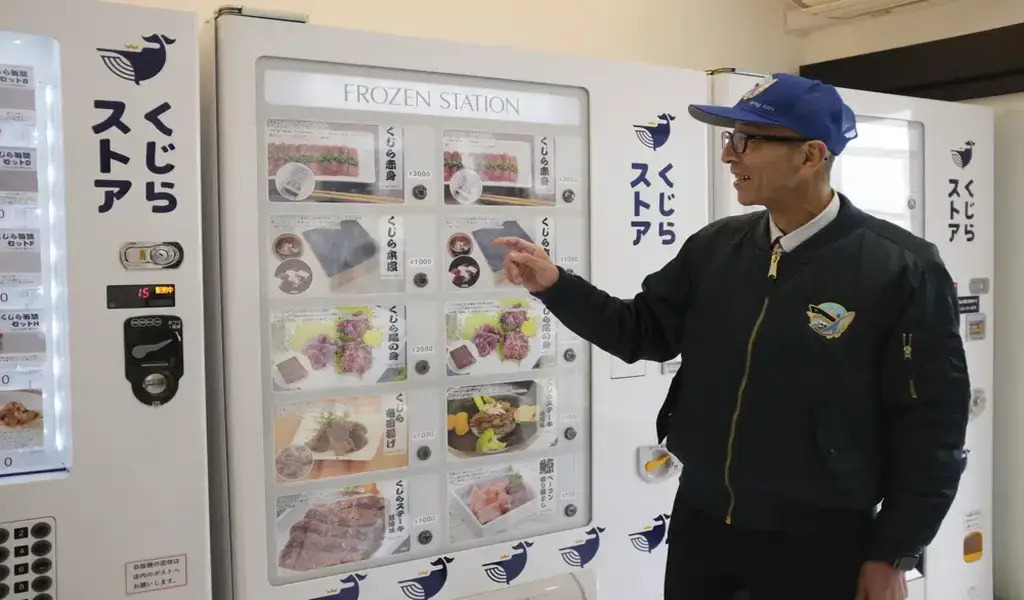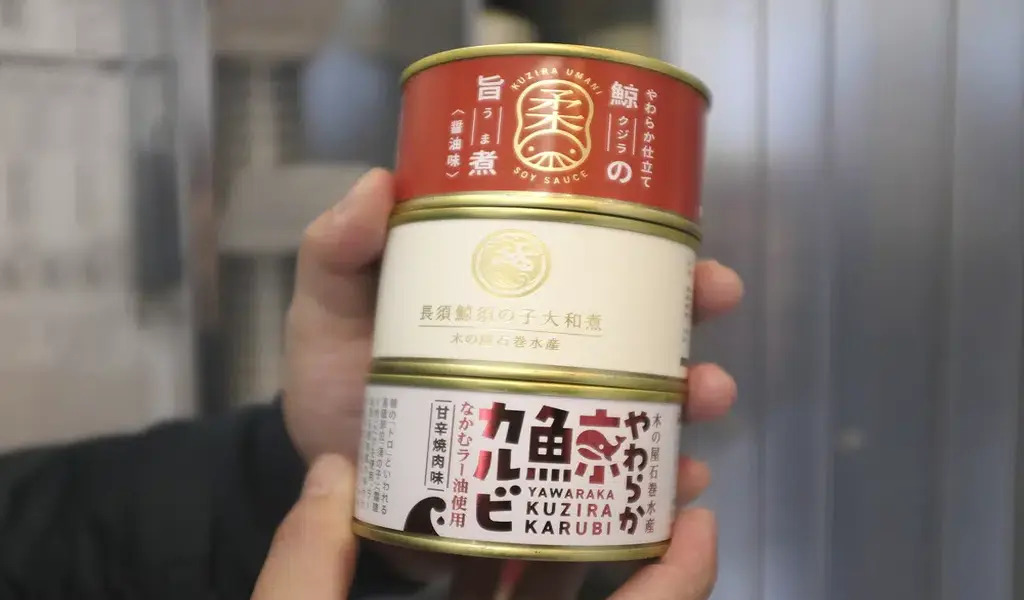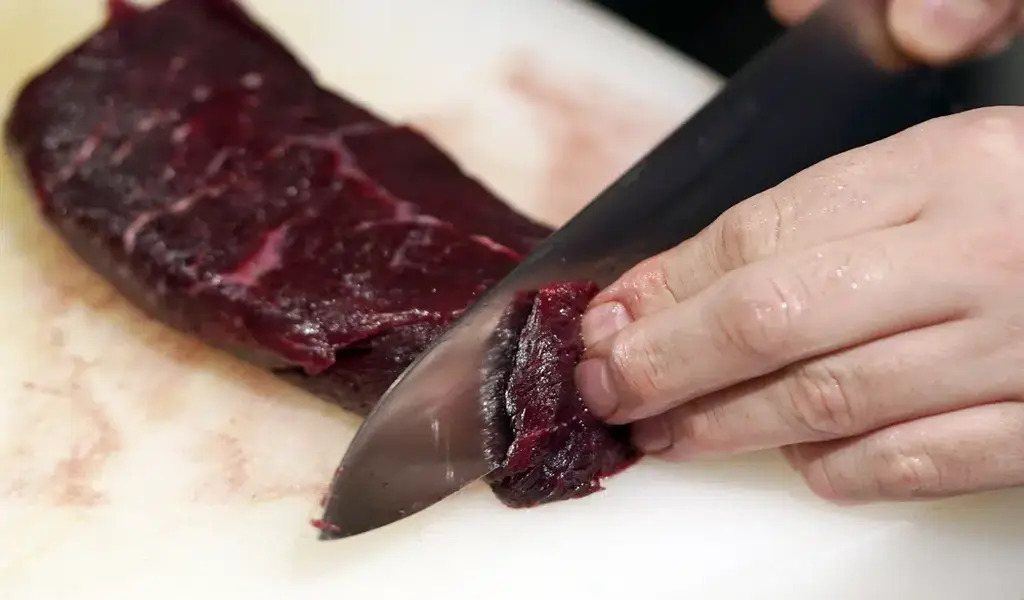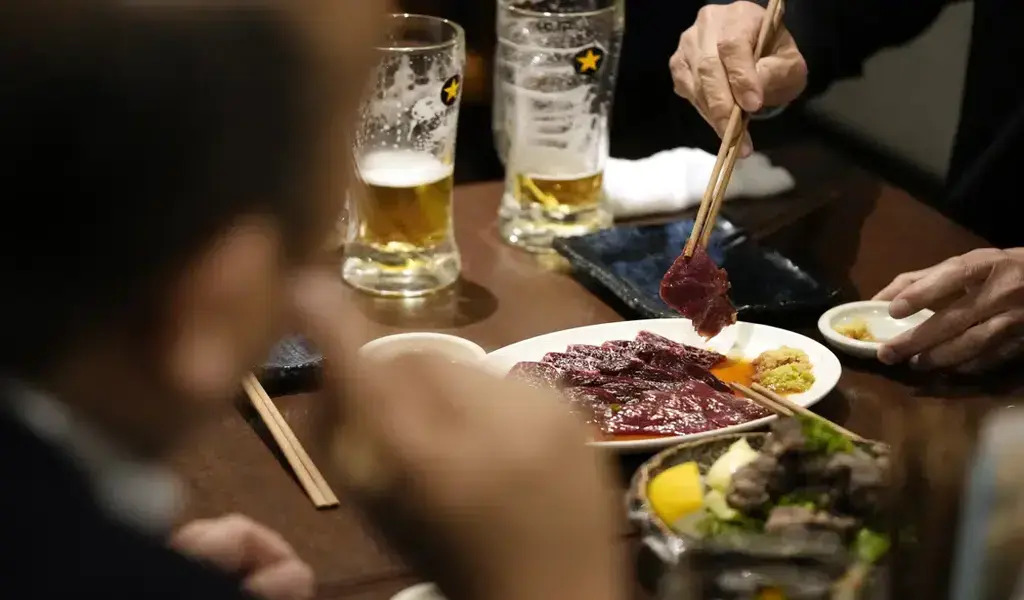Business
Japan Firm Installs Whale Meat Vending Machines To Boost Sales
(CTN NEWS) – TOKYO – After battling for years to market its goods despite objections from environmentalists, a Japanese whaling company has discovered a new strategy: whale meat vending machines.
In the port city of Yokohama, close to Tokyo, a new unmanned store called The Kujira (Whale) Store has just opened.
It has three machines for making whale sashimi, whale bacon, whale skin, whale steak, and canned whale meat. Prices start at 1,000 yen and go up to 3,000 yen ($7.70 to $23).
The third store to open in the Japanese capital region includes white vending machines with cartoon whale decorations.
After two others were unveiled in Tokyo earlier this year as a part of Kyodo Senpaku Co.’s new sales campaign, it opened on Tuesday.

/ AP
Although sales in the new vending machines have quietly started off well, the operator notes that whale meat has long been a contentious topic.
Since Japan ended its widely criticized research hunts in the Antarctic in 2019 and resumed commercial whaling off its coasts, anti-whaling demonstrations have subsided.
Environmentalists express concern that the action could pave the way for increased whaling.
The Iruka & Kujira (Dolphin & Whale) Action Network’s Nanami Kurasawa declared that the problem with vending machines was not the machines themselves but rather what they might cause.
Kurasawa pointed out that the operator of the whaling operation has already requested more catches and to expand whaling outside of the designated waters.
In five years, Kyodo Senpaku plans to install vending machines at 100 places across the country, according to company representative Konomu Kubo. In Osaka, a fourth will open the following month.
The plan is to instal vending machines close to supermarkets, where whale meat is typically unavailable, in order to create demand—a task essential for the sustainability of the sector.

/ AP
According to Kubo, major supermarket chains have mostly refrained from selling whale meat in order to quell anti-whaling group protests and exercise caution even if the harassment of activists has decreased.
“As a result, many consumers who want to eat whale meat cannot locate or purchase it. For those individuals, we installed vending machines at unmanned stores, the speaker remarked.
According to company representatives, sales at the two stores in Tokyo have exceeded expectations by a large margin, keeping staff members busy restocking inventory.
Mami Kashiwabara, a 61-year-old customer, immediately chose whale bacon at the shop in the Motomachi neighbourhood of Yokohama, an upscale retail zone next to Chinatown.
Whale bacon was her father’s favorite food. She was disappointed to discover that it had been sold out and had to make do with frozen onomi, a rare delicacy that is tail flesh.
Although Kashiwabara claims to be aware of the controversies surrounding whaling, she claims that eating whale meat reminds her of eating it as a child at meals with her family and during school lunches.

/ AP
“I do not believe that killing whales for no reason is good. However, whale meat is a staple of Japanese cuisine, and by appreciating whale meat, we can honor whales’ lives, according to Kashiwabara. If I could eat it, I would be pleased.”
Kashiwabara stated that she intended to enjoy some sake with her spouse after purchasing a 3,000 yen ($23) handy-size chunk.
Most of the flesh comes from whales captured off the northeastern coast of Japan.
After leaving the International Whaling Commission, Japan restarted commercial whaling in July 2019.
This ended 30 years of so-called “research whaling,” which conservationists had denounced as a pretext for the commercial hunts that the IWC had outlawed in 1988.
Japan caught 270 whales last year as part of its commercial whaling in its exclusive economic zone, less than 80% of its quota and less than the quantity it previously hunted in the Antarctic and the northwestern Pacific as part of its research programme.
Less minke whales were discovered near the coast, which led to the decline. According to Kurasawa, the cause of the decreased catch should be investigated to determine if overhunting or climate change are to blame.

The Yomiuri Shimbun
While environmental organizations opposed the return of commercial whaling, some view it as a chance for the government’s troubled and expensive whaling program to adapt to shifting trends and public preferences.
Kyodo Senpaku will build a new mother ship for 6 billion yen ($46 million) to replace the ailing Nisshin Maru in an effort to maintain the whaling industry in the decades to come.
But there is still ambiguity. Even in countries with whalers, like Iceland, whaling is waning.
According to Kubo, whales may also be avoiding the Japanese shores because of a lack of saury, a key component of their diet, and other fish, possibly due to climate change.
According to Fisheries Agency figures, just a few hundred people and one operator are involved in whaling in Japan, and it makes up less than 0.1% of the country’s overall meat consumption.
However, as a part of Japan’s cultural tradition, conservative lawmakers in power vehemently favour commercial whaling and the consumption of meat.

/ AP
Environmentalists say whale flesh is no longer consumed regularly in Japan, especially by younger people.
After World War II, when Japan was undernourished, whale meat was a cheap source of nutrition; in 1962, 233,000 tonnes were consumed annually.
Other meats quickly took the place of whales. In 1986, the year before the International Whaling Commission (IWC) outlawed the hunting of numerous whale species, the availability of whale meat dropped to 6,000 tonnes.
Japan caught up to 1,200 whales each year during the research whaling period, which has been accused as a cover for commercial hunts because the meat was sold on the market.
Following a rise in worldwide protests and a decline in domestic demand for whale flesh, it has significantly reduced its catch.
Between 3,000 and 5,000 tonnes of beef were imported yearly, including supplies from Norway and Iceland.

/ AP
According to Fisheries Agency figures, the quantity further decreased in 2019 to 2,000 tonnes, or 20 grammes (less than 1 ounce) of whale meat per person annually.
Whaling officials blamed the absence of imports caused by the pandemic for the decline in supply over the previous three years and now want to roughly treble this year’s supply with imports of more than 2,500 tonnes from Iceland.
Whaling officials claimed that Japan could convince Iceland’s only remaining whaler to only hunt fin whales for export to Japan. According to the IWC, Iceland only managed to catch one minke whale during the 2021 season.
The International Fund for Animal Welfare criticized Iceland’s export to Japan and stated that it “opposes all commercial whaling as it is intrinsically inhumane.”
The government should increase Japan’s yearly catch quota to levels that can supply around 5,000 tonnes, which Kubo views as the threshold to maintain the industry, given the uncertain future for imports.
From a long-term standpoint, Kubo believed the sector couldn’t be sustained at the current supply levels. Both supply and demand must be increased because they have both decreased.

/ AP
He continued, “Whale meat processing cannot be a profitable industry with the severely low supply and may not last for the next generations.”
When higher-quality whale meat became available through commercial whaling three years ago, Yuki Okoshi began serving dishes using whale meat at his Japanese-style seafood restaurant. He said he hoped the availability of whale meat would stabilise.
Okoshi claimed that whale meat restaurants may hold the key to survival and that “the future of the whale industry hinges on whether customers need us.”
The relationship between the restaurant and its clients is relatively straightforward, but whaling can be a contentious political topic, according to Okoshi.
“Our clients are satisfied because we provide wonderful meals at fair pricing. All there is to it is that.”
RELATED CTN NEWS:

Business
PepsiCo Reduces Revenue Projections As North American Snacks And Key International Markets Underperform.

(VOR News) – In the third quarter of this year, Pepsi’s net income was $2.93 billion, which is equivalent to $2.13 per share. This was attributed to the company.
This is in stark contrast to net income of $3.09 billion, which is equivalent to $2.24 per share, during the same period in the previous year. The company’s earnings per share were $2.31 when expenses were excluded.
Net sales decreased by 0.6%, totaling $23.32 billion. Organic sales increased by 1.3% during the quarter when the effects of acquisitions, divestitures, and currency changes are excluded.
Pepsi’s beverage sales fell this quarter.
The most recent report indicates that the beverage and food sectors of the organization experienced a 2% decline in volume. Consumers of all income levels are demonstrating a change in their purchasing habits, as indicated by CEOs’ statements from the previous quarter.
Pepsi’s entire volume was adversely affected by the lackluster demand they encountered in North America. An increasing number of Americans are becoming more frugal, reducing the number of snacks they ingest, and reducing the number of times they purchase at convenience stores.
Furthermore, Laguarta observed that the increase in sales was partially attributed to the election that occurred in Mexico during the month of June.
The most significant decrease in volume was experienced by Quaker Foods North America, which was 13%. In December, the company announced its initial recall in response to a potential salmonella infection.
Due to the probability of an illness, the recall was extended in January. Pepsi officially closed a plant that was implicated in the recalls in June, despite the fact that manufacturing had already been halted.
Jamie Caulfield, the Chief Financial Officer of Pepsi and Laguarta, has indicated that the recalls are beginning to have a lessening effect.
Frito-Lay experienced a 1.5% decline in volume in North America. The company has been striving to improve the value it offers to consumers and the accessibility of its snack line, which includes SunChips, Cheetos, and Stacy’s pita chips, in the retail establishments where it is sold.
Despite the fact that the category as a whole has slowed down in comparison to the results of previous years, the level of activity within the division is progressively increasing.
Pepsi executives issued a statement in which they stated that “Salty and savory snacks have underperformed year-to-date after outperforming packaged food categories in previous years.”
Pepsi will spend more on Doritos and Tostitos in the fall and winter before football season.
The company is currently promoting incentive packets for Tostitos and Ruffles, which contain twenty percent more chips than the standard package.
Pepsi is expanding its product line in order to more effectively target individuals who are health-conscious. The business announced its intention to acquire Siete Foods for a total of $1.2 billion approximately one week ago. The restaurant serves Mexican-American cuisine, which is typically modified to meet the dietary needs of a diverse clientele.
The beverage segment of Pepsi in North America experienced a three percent decrease in volume. Despite the fact that the demand for energy drinks, such as Pepsi’s Rockstar, has decreased as a result of consumers visiting convenience stores, the sales of well-known brands such as Gatorade and Pepsi have seen an increase throughout the quarter.
Laguarta expressed his opinion to the analysts during the company’s conference call, asserting, “I am of the opinion that it is a component of the economic cycle that we are currently experiencing, and that it will reverse itself in the future, once consumers feel better.”
Additionally, it has been noted that the food and beverage markets of South Asia, the Middle East, Latin America, and Africa have experienced a decline in sales volume. The company cut its forecast for organic revenue for the entire year on Tuesday due to the business’s second consecutive quarter of lower-than-anticipated sales.
The company’s performance during the quarter was adversely affected by the Quaker Foods North America recalls, the decrease in demand in the United States, and the interruptions that occurred in specific international markets, as per the statements made by Chief Executive Officer Ramon Laguarta.
Pepsi has revised its forecast for organic sales in 2024, shifting from a 4% growth rate to a low single-digit growth rate. The company reiterated its expectation that the core constant currency profitability per share will increase by a minimum of 8% in comparison to the previous year.
The company’s shares declined by less than one percent during premarket trading. The following discrepancies between the company’s report and the projections of Wall Street were identified by LSEG in a survey of analysts:
SOURCE: CNBC
SEE ALSO:
Old National Bank And Infosys Broaden Their Strategic Partnership.
Business
Old National Bank And Infosys Broaden Their Strategic Partnership.

(VOR News) – Old National Bank, a commercial bank with its headquarters in the Midwest, and Infosys, a firm that specializes in information technology, have recently entered into a strategic expansion of their link, which has been in place for the past four years.
This expansion is more likely to take place sooner rather than later, with the likelihood being higher.
For the purpose of making it possible for Old National Bank to make use of the services, solutions, and platforms that are offered by Infosys, the objective of this expansion is to make it possible for the bank to transform its operations and processes through the application of automation and GenAI, as well as to change significant business areas.
This lets the bank leverage Infosys’ services, solutions, and platforms.
Old National Bank Chairman and CEO Jim Ryan said, “At Old National, we are committed to creating exceptional experiences for both our customers and our fellow employees.”
This statement is applicable to Old National Bank. Infosys is carefully managing the business process innovations that it is putting us through, putting a strong emphasis on efficiency and value growth throughout the process to ensure that it is carried out efficiently.
This is a routine occurrence throughout the entire operation. Because of Infosys’ dedication to our development and success, we are incredibly appreciative of the assistance they have provided.
Old National has been receiving assistance from Infosys in the process of updating its digital environment since the year 2020, according to the aforementioned company.
Ever since that time, the company has been providing assistance. The provision of this assistance has been accomplished through the utilization of a model that is not only powerful but also capable of functioning on its own power.
Infosys currently ranks Old National thirty-first out of the top thirty US banks.
This ranking is based on the fact that Old National is the nation’s largest banking corporation.
It is estimated that the total value of the company’s assets is approximately fifty-three billion dollars, while the assets that are currently being managed by the organization are valued at thirty billion dollars.
Dennis Gada, the Executive Vice President and Global Head of Banking and Financial Services, stated that “Old National Bank and Infosys possess a robust cultural and strategic alignment in the development, management, and enhancement of enterprise-scale solutions to transform the bank’s operations and facilitate growth.”
This remark referenced the exceptional cultural and strategic synergy between the two organizations. Dennis Gada is the one who asserted this claim. This was articulated explicitly concerning the exceptional cultural congruence and strategy alignment of the two organizations.
We are pleased to announce that the implementation of Infosys Topaz will substantially expedite the transformation of Old National Bank’s business processes and customer service protocols. We are exceedingly enthusiastic about this matter. We are quite thrilled about this specific component of the scenario.
Medium-sized banks operating regionally will continue to benefit from our substantial expertise in the sector, technology, and operations. This specific market segment of Infosys will persist in benefiting from our extensive experience. This phenomenon will enable this market sector to sustain substantial growth and efficiency benefits.
SOURCE: THBL
SEE ALSO:
American Water, The Largest Water Utility In US, Is Targeted By A Cyberattack
States Sue TikTok, Claiming Its Platform Is Addictive And Harms The Mental Health Of Children
Qantas Airways Apologizes After R-Rated Film Reportedly Airs On Every Screen During Flight
Business
American Water, The Largest Water Utility In US, Is Targeted By A Cyberattack

The largest regulated water and wastewater utility company in the United States stated Monday that it had been the target of a cyberattack, forcing the company to halt invoicing to consumers.
American Water, The Largest Water Utility In US, Is Targeted By A Cyberattack
American Water, based in New Jersey and serving over 14 million people in 14 states and 18 military facilities, said it learned of the unauthorized activity on Thursday and quickly took precautions, including shutting down certain systems. The business does not believe the attack had an impact on its facilities or operations and said employees were working “around the clock” to determine the origin and scale of the attack.

According to their website, American Water operates over 500 water and wastewater systems in around 1,700 communities across California, Georgia, Hawaii, Illinois, Indiana, Iowa, Kentucky, Maryland, Missouri, New Jersey, Pennsylvania, Tennessee, Virginia, and West Virginia.
SOURCE | AP
-

 News3 years ago
News3 years agoLet’s Know About Ultra High Net Worth Individual
-
Entertainment2 years ago
Mabelle Prior: The Voice of Hope, Resilience, and Diversity Inspiring Generations
-

 Health4 years ago
Health4 years agoHow Much Ivermectin Should You Take?
-

 Tech2 years ago
Tech2 years agoTop Forex Brokers of 2023: Reviews and Analysis for Successful Trading
-

 Lifestyles3 years ago
Lifestyles3 years agoAries Soulmate Signs
-

 Movies2 years ago
Movies2 years agoWhat Should I Do If Disney Plus Keeps Logging Me Out of TV?
-

 Health3 years ago
Health3 years agoCan I Buy Ivermectin Without A Prescription in the USA?
-

 Learning3 years ago
Learning3 years agoVirtual Numbers: What Are They For?